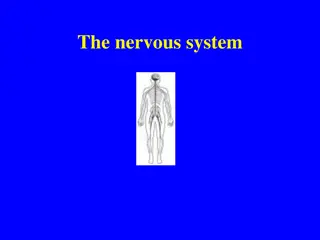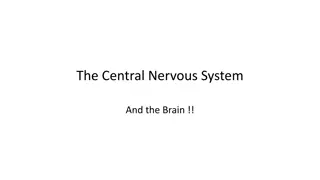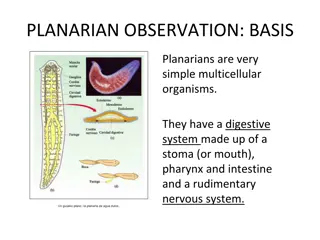Overview of the Central Nervous System and Neurotransmitters
The human central nervous system (CNS) is composed of neurons that transmit information through electrical impulses and neurotransmitters at synaptic junctions. Synapses play a crucial role in interneuronal communication, with various types and features impacting information transmission. Neurotransmitters like acetylcholine, monoamines, amino acids, and neuropeptides regulate CNS functions and behavior. Understanding the organization and function of the CNS, as well as neurotransmitter roles, is essential in addressing neurological conditions and cognitive activities.
Download Presentation

Please find below an Image/Link to download the presentation.
The content on the website is provided AS IS for your information and personal use only. It may not be sold, licensed, or shared on other websites without obtaining consent from the author. Download presentation by click this link. If you encounter any issues during the download, it is possible that the publisher has removed the file from their server.
E N D
Presentation Transcript
Cells Cells and central central nervous nervous system and organization organization of system (CNS) of (CNS) 02. 10. 2018. Imre Ol h
The human CNS has an extraordinary capacity to store and retrieve information to regulate behavior and emotion. The functional unit of CNS is the neuron, which is an excitable cell. The interneuronal communication takes place at synaptic junction. The transmission of information from one cell to other cell takes place by electrical impulse or action potential. When an action potential reaches the axon terminal, it triggers to release classical substance or neurotransmitter, which is rend by specialized receptor on the recipient neuron, and initiates action potential.
General feature of synapses asymmetrical - postsynaptic density is thicker than the presynapic density - excitatory spherical presynaptic vesicles neurotransmitter symmetrical - postsynaptic density is similar in thickness to the presynaptic density - ellipsoidal or spherical presynaptic vesicles - inhibitors Types of synapsis axondendritic, axospinous, axosomatic, axoaxonal - non-directed synapses - cathecolamines - swelling - electrical synapse - gap junction - no synaptic - bidirectional - inferior olivary nucleus
Neurotransmitters Acetylcholine Monoamine: cathecholamines, indolamines Amino acids: GABA, glicine, glutamic acid Neuropeptides: encephalins, endorphine, substance P, cholecystokinin
Acetylcholine First neurotransmitter indentified Extensive distribution: interneuron, limbic system, moto neurons Inactivation - acetylcholinesterase Cholinergic neuron: learning, memory, cognitive activity Parkinson disease: decreased dopaminergic activity <-> increased acetylcholine
Monoamines Low level of catecholamine -> depression High level of catecholamine -> euphoria Sympathetic system - norepinephrin Dopamin, serotonin in the CNS Indolamines: serotonin - raphe nuclei, histamin - mamillary nuclei
Amino acid transmitter GABA - inhibitory transmitter - Purkinje-cells Lack of GABA in substantia nigra, putamen and caudate nuclus - involuntary choreiform movement Glicine - ventral horn of spinal chord Glutamine acid - GABA precursor Neuropeptide Endorphines naturally occuring opiates bind to opiate receptore results in analgesia
TELENCEPHALON Brodmann areas
Frontal lobe Primary motor center: Br 4 --> precentral gyrus Frontal eyefield: Br 8 --> middle frontal gyrus Broca's motor speach center: Br 44, 45 --> inferior frontal gyrus Premotor area: Br 6 and 8 stimulations --> uncoordinated movement Parietal lobe Postcentral gyrus: Br 3, 1, 2 --> primary sensory center Br 3 --> joint sensation Br 1 --> cutanous sensation Br 1 and 2 --> joint Superior parietal lobe Br 5 and 7 --> impair ability to recognize contralateral side of body
Temporal lobe Superior temporal lobe, gyrus of Heschl Br 41,42 --> primary auditory cortex Parahippocampal gyrus - limbic system Occipital lobe Sulcus calcarinus: Br 17, 18, 19 --> visual system Insular lobe Modulatory role in recognation, fine touch, taste, auditory impulses Limbic lobe
Archipallium Hippocampus, dentate gyrus, parahippocampal gyrus, subiculum - is a transitional zone between 6 and 8 layer of the cortex Paleopallium olfactory cortex - limbic system archi and paleopallium: consists of 3 layers allocortex Neocortex - neopallium 90% of cortex isocortex - 6 layer
Histology of isocortex I. Molecular layer: horizontal cells, pyramidal dendrites II. External granular layer: granular and small pyramidal cells - project up and down - intracortical circulus III. External pyramidal layer - association fibers - opposite hemisphere on comissural fibers IV. Internal granular layer - sensory projections from thalamus V. Internal pyramidal layer - Betz-corticospinal, corticobulbar fibers VI. Multiform layer - projecting to the thalamus Agranular - motor cortex - frontal lobe Granular - sensory cortex - parietal lobe
Types of fibers association fibers projection fibers commissural fibers























